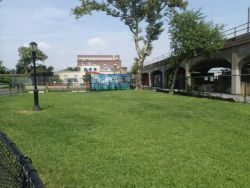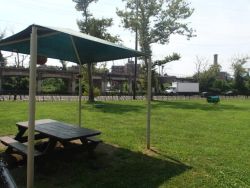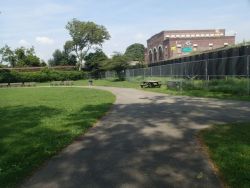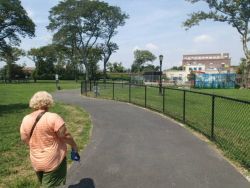Rockaway Freeway
Rockaway Freeway
The Rockaway Freeway parks are intermittent parcels of land that extend from Beach 22nd Street to Beach 108th Street. Located adjacent to the 4.5 miles of freeway, they beautify the roadside in Far Rockaway, Edgemere, Arverne, Hammels, and Seaside. Beach 67th to 69th Streets and Beach 81st to 83rd Streets, respectively, bound the two parcels that are most commonly used. Both are on the north side of the freeway.
The Beach 67th park is located at the stairwell entrance of the A train elevated station Beach 67th Street/Gaston Av. The park provides green space for neighborhood residents and subway riders. The area has several trees, primarily London planetrees. The Beach 81st park is triangular as a result of its proximity to the train tracks. As the A train enters the Rockaway Peninsula from Broad Channel, the track diverges to serve the opposite ends of the peninsula. The park lies in the triangular section formed by this split and the freeway to the south. The park has grass space with various species of trees including Honeylocust (Gleditsia triacanthos), Linden (Tilia), London planetree (Platanus x acerifolia), and Hawthorn (Crataegus). Parks acquired these properties in 1946.
The name Rockaway was probably derived from the Delaware or Chippewa Native American Language words for sandy place (lekau akie). The region became known as Rockaway after it was colonized by Europeans during the 17th century.
Rockaway Freeway is located under the elevated tracks of the A train. Originally, the Long Island Railroad served the Rockaways. During the 1870s, the railroad increased its service. Open-air cars crowded with beach goers began to arrive during the summer months. In 1905, the Long Island Railroad began electrifying the system, and steam trains became obsolete.
In 1950, the New York City Transit Authority purchased the original Long Island Railroad route, running across wooden bridges in Jamaica Bay. The trestles periodically caught fire, and after serious damage the Long Island Railroad canceled service. Instead of repairing the trestles, the Transit Authority proposed building embankments from dredged sand. The proposal precipitated a political clash with Parks Commissioner Robert Moses. In his view, the dredging would damage the valued wetlands of Jamaica Bay Park. The compromise reached stipulated that in conjunction with the dredging, the Transit Authority would build dikes to create freshwater ponds in Jamaica Bay Park. The ponds would attract waterfowl to the newly created Jamaica Bay Wildlife Refuge (1951). The refuge continues to preserve the meadowlands, wetlands, and wildlife of Jamaica Bay.
Check out your park's Vital Signs
Clean & Safe
Green & Resilient
Empowered & Engaged Users
Share your feedback or learn more about how this park is part of a
Vital Park System




